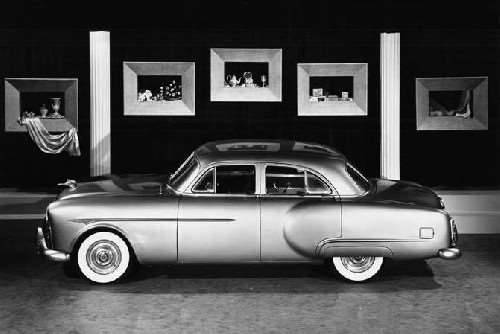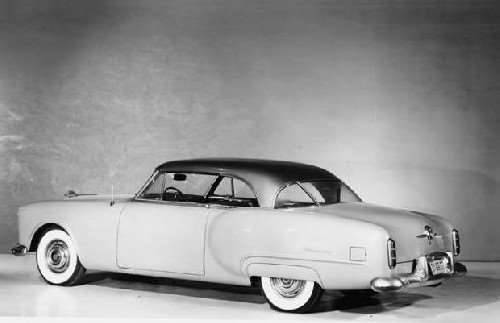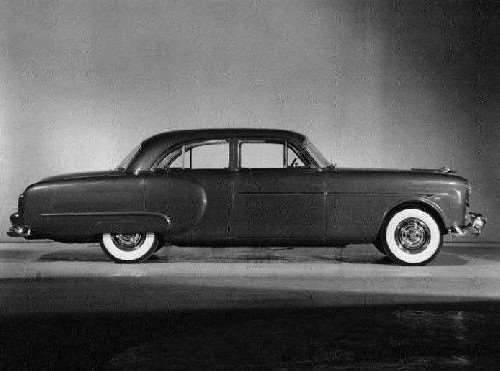Re: Packard Seniors 1940-56
Posted by Mahoning63 On 2015/5/8 19:53:27
Am not sure history has recorded the tremendous opportunity that lay before Packard as it set out to craft its 1951 models. The company may not have realized it (though it should have!) but beginning in 1951 it could have gone toe-to-toe with Cadillac and greatly increased its financial health in the process. The two elements were interdependent. Packard was about luxury cars. No luxury cars, no Packard. For 1951 the task was not simply to chase Cadillac's 60 Special and 75, it was to get out of the rat race started with the necessary-at-the-time One Twenty and get back to making pure luxury cars. Like in the 1920s this meant offering a respectable luxury entry that generated most of the volume, and carefully building on its underpinnings to fill out the showroom with all the good stuff expected from the best-of-the-best.
Size mattered in the 1951 luxury market. So did pricing, power and styling. Tables 1 and 2 make it clear that Packard's 400 Patrician was not competitive with 60 Special in the first three categories and I would argue that styling could have been better too. The Patrician's luxurious and roomy interior alone was not enough to carry the day, the top sedan needed to be long, handsome and elegant, the King of the Road.
Before we start adding inches to the 1951-4 models, a point about Packard body styling. In the company's heyday the body elements (windshield, backlight, C- and D-pillar shape, decklids) were largely common from entry through top models excepting customs. The only changes were in door, roof and hood length. The grill was also common. I like this strategy because it gave Packard one voice. You bought a Packard, you got a Packard. A luxurious Packard. Let's use it again.
As with the '56 work-up I will use the body styling details that Packard had created, reworking only their dimensions and application. As Steve knows, I don't like broken surfaces and glass mullions so you largely won't see them in the work ups.
When GM opened the Fifties it opened up its greenhouses in the C-bodies with slender pillars and lots of glass. This signaled modernity. For Packard the most slender 1951 C-pillar was the 200's, which also visually pulled the greenhouse back whereas the 300/400's pushed it a bit forward and made the rear roof look a bit tall and heavy. The 200's backlight was also of clean one piece design with no mullions. For these reasons and the goal of establishing one common Packard sedan "look" I use it for all Packard sedans. The 200 sedan had good hood/roof/decklid proportions so the only change I would have made would have been removal of body insert between the front and rear doors. Hudson did this for 1948 so no excuses Packard!
The big changes to the 200 would have been in the interior, which would been of 300 quality including broadcloth, and the price, which would have been several hundred dollars higher than the actual 200 or around $2,900. I would have also reworked the grill; more on that in next post on the 1953-54 cars. Powering the 200 would have been the 288 Eight. Maybe the series could have been called simply the Eight or perhaps the 200 Eight Clipper.
There would have been no 200 coupe, that tooling capital better spent on one line of spectacular 2-door cars, the former 250 hardtop coupe and convertible. These would have become the 300 or 300 Super Eight Victoria series running with the 327 Eight. They would not have been as tall as what came to be, instead lowered two inches forward of the decklid and rear fenders, both of which would have been carried over from the 200 sedan. I ragged on such lowering in a previous post but alas, here it is. Two inches wouldn't have been that detrimental to seating comfort, would it? Would have done wonders to the proportions. The cars would have sat on the 200 sedan's 122 inch chassis with the windshield moved back a few inches to sinc up with the move rearward of the lowered front seats and I/P. I have shown this work-up before but will do so again for the benefit of those who haven't seen it.
Finally the 400 or 400 Custom Eight Patrician in all its bafflegab, with 356 Eight under hood. Sitting on a 132 inch wheelbase it would have had same greenhouse length and rear legroom as actual Patrician but now with doors 2-1/2 inches longer. I recall comments made in this forum that rear ingress/egress in Packard Contour sedans could have been better, so the longer rear doors would have served a functional purpose as well as giving the car the appearance of greater length. Increases of 5 inches to hood and rear overhang/decklid would have completed the Patrician's transformation. Key to investment affordability would have been to shape the Patrician's front fenders, hood, door panels and decklid such that its tooling could be used to stamp the shorter panels used in the 200 sedan. The Contour's side panels appear to curve into the body as they move rearward, which would have presented a problem for this strategy but I offer it because the Executive limo somehow visually gets away with rear doors that add an extra 27 inches to the 200 coupe's body length while not looking like the surface loses it tangent.
Will talk about limos and volumes/pricing/profits in the 1953-54 post. For those still with me, thanks for hanging in there! As usual, all thoughts welcome.
Attach file:
 (34.47 KB)
(34.47 KB)

 (20.28 KB)
(20.28 KB)

 (40.35 KB)
(40.35 KB)

Size mattered in the 1951 luxury market. So did pricing, power and styling. Tables 1 and 2 make it clear that Packard's 400 Patrician was not competitive with 60 Special in the first three categories and I would argue that styling could have been better too. The Patrician's luxurious and roomy interior alone was not enough to carry the day, the top sedan needed to be long, handsome and elegant, the King of the Road.
Before we start adding inches to the 1951-4 models, a point about Packard body styling. In the company's heyday the body elements (windshield, backlight, C- and D-pillar shape, decklids) were largely common from entry through top models excepting customs. The only changes were in door, roof and hood length. The grill was also common. I like this strategy because it gave Packard one voice. You bought a Packard, you got a Packard. A luxurious Packard. Let's use it again.
As with the '56 work-up I will use the body styling details that Packard had created, reworking only their dimensions and application. As Steve knows, I don't like broken surfaces and glass mullions so you largely won't see them in the work ups.
When GM opened the Fifties it opened up its greenhouses in the C-bodies with slender pillars and lots of glass. This signaled modernity. For Packard the most slender 1951 C-pillar was the 200's, which also visually pulled the greenhouse back whereas the 300/400's pushed it a bit forward and made the rear roof look a bit tall and heavy. The 200's backlight was also of clean one piece design with no mullions. For these reasons and the goal of establishing one common Packard sedan "look" I use it for all Packard sedans. The 200 sedan had good hood/roof/decklid proportions so the only change I would have made would have been removal of body insert between the front and rear doors. Hudson did this for 1948 so no excuses Packard!
The big changes to the 200 would have been in the interior, which would been of 300 quality including broadcloth, and the price, which would have been several hundred dollars higher than the actual 200 or around $2,900. I would have also reworked the grill; more on that in next post on the 1953-54 cars. Powering the 200 would have been the 288 Eight. Maybe the series could have been called simply the Eight or perhaps the 200 Eight Clipper.
There would have been no 200 coupe, that tooling capital better spent on one line of spectacular 2-door cars, the former 250 hardtop coupe and convertible. These would have become the 300 or 300 Super Eight Victoria series running with the 327 Eight. They would not have been as tall as what came to be, instead lowered two inches forward of the decklid and rear fenders, both of which would have been carried over from the 200 sedan. I ragged on such lowering in a previous post but alas, here it is. Two inches wouldn't have been that detrimental to seating comfort, would it? Would have done wonders to the proportions. The cars would have sat on the 200 sedan's 122 inch chassis with the windshield moved back a few inches to sinc up with the move rearward of the lowered front seats and I/P. I have shown this work-up before but will do so again for the benefit of those who haven't seen it.
Finally the 400 or 400 Custom Eight Patrician in all its bafflegab, with 356 Eight under hood. Sitting on a 132 inch wheelbase it would have had same greenhouse length and rear legroom as actual Patrician but now with doors 2-1/2 inches longer. I recall comments made in this forum that rear ingress/egress in Packard Contour sedans could have been better, so the longer rear doors would have served a functional purpose as well as giving the car the appearance of greater length. Increases of 5 inches to hood and rear overhang/decklid would have completed the Patrician's transformation. Key to investment affordability would have been to shape the Patrician's front fenders, hood, door panels and decklid such that its tooling could be used to stamp the shorter panels used in the 200 sedan. The Contour's side panels appear to curve into the body as they move rearward, which would have presented a problem for this strategy but I offer it because the Executive limo somehow visually gets away with rear doors that add an extra 27 inches to the 200 coupe's body length while not looking like the surface loses it tangent.
Will talk about limos and volumes/pricing/profits in the 1953-54 post. For those still with me, thanks for hanging in there! As usual, all thoughts welcome.
Attach file:
 (34.47 KB)
(34.47 KB)
 (20.28 KB)
(20.28 KB)
 (40.35 KB)
(40.35 KB)
This Post was from: https://packardinfo.com/xoops/html/modules/newbb/viewtopic.php?post_id=161473